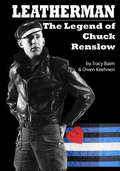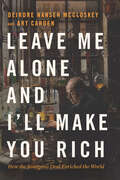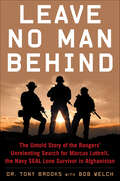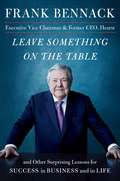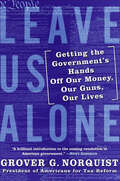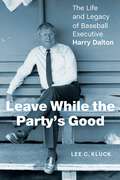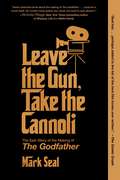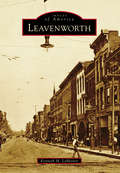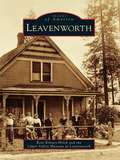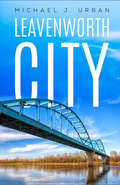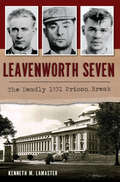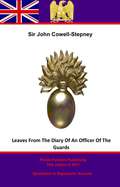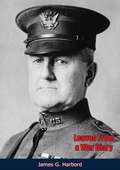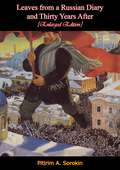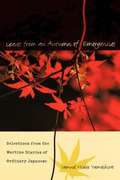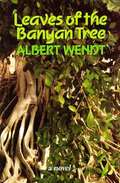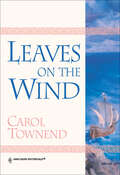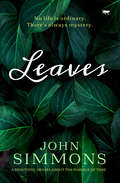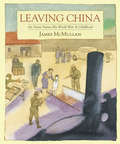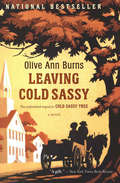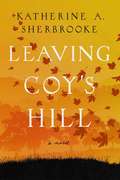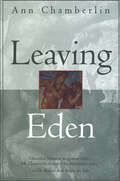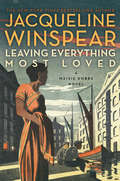- Table View
- List View
Leatherman: The Legend of Chuck Renslow
by Tracy Baim Owen KeehnenA prominent Chicago gay activist and entrepreneur is the subject of an in-depth biography, Leatherman: The Legend of Chuck Renslow, by journalists and authors Tracy Baim and Owen Keehnen. Living as an openly gay man in 1950s Chicago was no easy task. For Chuck Renslow, that was only his first of many bold moves. Just out of high school he began what was to become a six-decade empire, starting more than two dozen businesses in Chicago, as well as a few in other cities. He has owned bars, discos, photo studios, health clubs, bathhouses, gay magazines and newspapers, hotels, restaurants, and bookstores. Throughout it all he dealt with Mafia and police payoffs, anti-gay political policies, harassment from censors, and even controversy within the gay community. In the mid-1950s, after having a portrait and then cheesecake studio, Renslow began experimenting with beefcake photography and began Kris Studio. With his longtime lover, the artist Dom Orejudos aka Etienne and Stephen, at his side, Renslow created Kris Studio a leader in male physique photography, resulting in such magazines as Triumph, Mars and The Rawhide Male, producing thousands of erotic images as well as several films. In 1959 Renslow took over the Gold Coast Show Lounge and transformed it into one of the most lowdown libidinous gay leather bars in the world. With Etienne's murals adorning the walls, a leather/Western/uniform dress code for patrons, and a dark Pit that featured all sorts of goings-on, the Gold Coast set the standard for raunchy kink and gay sexual liberation. It was the birthplace of motorcycle clubs and sex groups, but above all a place for people to meet, connect, and explore themselves and their sexuality. The Gold Coast was also the birthplace of the first leather contest, which in the span of a few short years evolved beyond the bar's capacity and became International Mr. Leather in 1979. More than three decades later, it continues to be one of the world's most popular gay events. Renslow was also one of the pioneers in taking a bathhouse beyond merely the borders of a mere sex club. Man's Country became something truly unforgettable in the 1970s - a sex-and-entertainment complex with a variety of rooms, shops, and a Music Hall that attracted top names touring in the "K-Y circuit," from Sally Rand to Wayland Flowers to Rusty Warren and Charles Pierce. Renslow was a dynamic force in Chicago politics under mayors starting with Richard J. Daley, and he ran to be a delegate for Sen. Ted Kennedy's 1980 presidential run. He danced with another man at a 1977 inaugural ball for Jimmy Carter. Renslow helped protest against unfair policies, fought censorship and entrapment, and battled Anita Bryant. He even served as a field contact for the pioneering work at the Kinsey Institute, as well as performing sexual acts for Kinsey researchers. He knew entertainment celebrities from Marlene Dietrich to Rudolf Nureyev, from Divine to Grace Jones, and from Sylvester to Quentin Crisp. In their heyday Chuck Renslow's annual White Parties were celebrations beyond compare. When Chicago's gay community faced the loss of its newspaper, Renslow bailed out and ran GayLife. He also co-founded the Leather Archives & Museum (with Tony DeBlase). Through it all Renslow has also been Daddy of the Family, a unique created group of lovers, tricks, and friends who were bound by sex and oftentimes love and by a goal of providing comfort and support to one another.
Leave It to Abigail!: The Revolutionary Life of Abigail Adams
by Barb RosenstockIn this inspiring tribute, award-winning author Barb Rosenstock and New York Times bestselling artist Elizabeth Baddeley tell the true story of one of America's greatest founding mothers: Abigail Adams.Everyone knew Abigail was different.Instead of keeping quiet, she blurted out questions. Instead of settling down with a wealthy minister, she married a poor country lawyer named John Adams. Instead of running from the Revolutionary War, she managed a farm and fed hungry soldiers. Instead of leaving the governing to men, she insisted they "Remember the Ladies." Instead of fearing Europe's kings and queens, she boldly crossed the sea to represent her new country. And when John become President of the United States, Abigail became First Lady, and a powerful advisor.Leave it to Abigail--an extraordinary woman who surprised the world.
Leave Me Alone and I'll Make You Rich: How the Bourgeois Deal Enriched the World
by Deirdre Nansen McCloskey Art CardenThe economist and historian Deirdre Nansen McCloskey has been best known recently for her Bourgeois Era trilogy, a vigorous defense, unrivaled in scope, of commercially tested betterment. Its massive volumes, The Bourgeois Virtues, Bourgeois Dignity, and Bourgeois Equality, solve Adam Smith’s puzzle of the nature and causes of the wealth of nations, and of the moral sentiments of modernity. The world got rich, she argues, not chiefly by material causes but by an idea and a sentiment, a new admiration for the middle class and its egalitarian liberalism. For readers looking for a distillation of McCloskey’s magisterial work, Leave Me Alone and I’ll Make You Rich is what you’ve been waiting for. In this lively volume, McCloskey and the economist and journalist Carden bring together the trilogy’s key ideas and its most provocative arguments. The rise of the west, and now the rest, is the story of the rise of ordinary people to a dignity and liberty inspiring them to have a go. The outcome was an explosion of innovation after 1800, and a rise of real income by an astounding 3,000 percent. The Great Enrichment, well beyond the conventional Industrial Revolution, did not, McCloskey and Carden show, come from the usual suspects, capital accumulation or class struggle. It came from the idea of economic liberty in Holland and the Anglosphere, then Sweden and Japan, then Italy and Israel and China and India, an idea that bids fair in the next few generations to raise up the wretched of the earth. The original shift to liberalism arose from 1517 to 1789 from theological and political revolutions in northwest Europe, upending ancient hierarchies. McCloskey and Carden contend further that liberalism and “innovism” made us better humans as well as richer ones. Not matter but ideas. Not corruption but improvement. Leave Me Alone and I’ll Make You Rich draws in entertaining fashion on history, economics, literature, philosophy, and popular culture, from growth theory to the Simpsons. It is the perfect introduction for a broad audience to McCloskey’s influential explanation of how we got rich. At a time when confidence in the economic system is under challenge, the book mounts an optimistic and persuasive defense of liberal innovism, and of the modern world it has wrought.
Leave No Man Behind: The Untold Story of the Rangers' Unrelenting Search for Marcus Luttrell, the Navy SEAL Lone Survivor in Afghanistan
by Bob Welch Tony BrooksA story of courage, perseverance, and patriotism behind the 75th Ranger Regiment's rescue mission following one of the deadliest Special Ops incidents in Afghanistan—a grueling search for twelve Navy SEAL casualties and eight downed Night Stalkers . . . but just one lone survivor On June 28th, 2005, a four-man Navy SEAL reconnaissance team under Operation Red Wings was ambushed in northeastern Afghanistan—as depicted in the book and film Lone Survivor. A quick reaction force was dispatched. Turbine 33, carrying eight Navy SEALs and eight members of the 160th Special Operations Aviation Regiment, was struck by a rocket propelled grenade—careening the dual rotor Chinook toward the rugged peak of Sawtalo Sar. The result was the single deadliest incident in Special Operations history at the time. Commanders called on the largest element of US Special Forces, the 75th Ranger Regiment. The rescue mission: Operation Red Wings II. Author Tony Brooks gives a first-hand account of the daring recovery of Turbine 33 and the subsequent search for the remaining compromised Navy SEAL recon team—one of whom was Marcus Luttrell, the lone survivor. The Rangers were up against lack of intel, treacherous terrain, violent weather, and an enemy that was raised to fight. Tony Brooks lived—and many of his fellow Rangers died—by the axiom, “Leave No Man Behind.” He is the first to tell the story other books and films have omitted, one of overcoming overwhelming odds to accomplish a mission: to bring every American soldier home.
Leave Something on the Table: and Other Surprising Lessons for Success in Business and in Life
by Frank BennackOne of the most innovative minds in business provides an equally original guide to getting ahead.Frank Bennack’s accomplishments in media and business are unrivaled. He was named chief executive of Hearst in 1979, and for nearly 30 years he helped solidify the company’s reputation as a leader in consumer media, overseeing the purchase of more than two dozen television stations and several major newspapers (Houston Chronicle), the launch of top-selling magazines (O, The Oprah Magazine), and a partnership with ABC, now the Walt Disney Company, to create the pioneering cable networks A&E, HISTORY, and Lifetime. One of his greatest achievements was when, in 1990, he negotiated a 20 percent stake in ESPN for $167 million. The sports network would be valued by market analysts at roughly $30 billion. He also played a key role in Hearst’s march toward diversification, with acquisitions of business media assets including global ratings agency Fitch Group. In Leave Something on the Table, Bennack takes readers behind the scenes of these high-stakes moves and offers practical tips for excelling in the corporate world and beyond. He tells stories from his Texas childhood—a first job at 8, his own television show at 17—that foretold why he would become a CEO at 46. And he shares his encounters with US presidents, reflects on his longtime commitment to philanthropy, and describes his and his colleagues’ unwavering quest to build the visionary Hearst Tower. This is a heartfelt handbook for how to advance not only as a professional but as a person. As Bennack writes, “It’s not currently fashionable to make the case for the high road. It looks longer, and old-fashioned, and it’s easy to conclude that while you’re climbing the ladder, burdened by your values, others are reaching the top faster. But if the stories in these pages suggest a broader truth, it’s exactly the opposite: The high road is quicker, with a better view along the way, and more satisfaction at the summit.”
Leave Us Alone: Getting the Government's Hands Off Our Money, Our Guns, Our Lives
by Grover G. NorquistThe new political movement that now controls much of the Republican party is a coalition of Americans who simply wish to be left alone by the government. They want to be free to run a business, keep the money they earn, own a gun, practice their faith, and perhaps homeschool their children—in short, to control their own destinies. Directly opposed is the descriptively titled Takings Coalition, which is at the heart of the tax-and-spend left. These forces will battle for control of America's future over the next fifty years.In this compelling and powerful narrative, Grover Norquist describes the two competing coalitions in American politics, what they can achieve and what they cannot do, and how you may fit into the contest. Required reading for anyone who wants a deeper understanding of politics in America today, Leave Us Alone outlines the order of battle for the next generation.
Leave While the Party’s Good: The Life and Legacy of Baseball Executive Harry Dalton
by Lee C. KluckHarry Dalton was a front office executive in Major League Baseball for more than forty years, serving as general manager for the Baltimore Orioles (1966–71), the California Angels (1972–77), and the Milwaukee Brewers (1978–91). He was the principal architect of the Orioles&’ dynasty and of the only American League Championship the Brewers ever won. In this definitive biography of Dalton (1928–2005), Lee C. Kluck tells the full and colorful story of a man many consider the first modern baseball executive. In 1965 the Orioles hired Dalton to be the chief team builder and to oversee baseball operations. This was a turning point in the history of baseball, creating a new kind of executive that other teams soon began to model. In Leave While the Party&’s Good Kluck details Dalton&’s pre-baseball life, showing that from an early age he developed traits that would shape the rest of his life in baseball. Dalton&’s early career in Baltimore, building up the organization&’s farm system, would inform his later days in higher management and help turn the Orioles into a dynasty. Dalton&’s move to California coincided with the arrival of free agency, forcing him to evolve his team-building approach. Following his departure from the California Angels after trading for the pieces that would make them winners in 1978, Dalton hired on with the Milwaukee Brewers&’ owner Bud Selig and made the Brewers a winning team for most of the next decade, including another pennant in 1982. Dalton won with big payrolls and small ones. He won before and after free agency. He built winning teams from nothing. Leave While the Party&’s Good details all this and gives insight into how his legacy continues to influence baseball today.
Leave the Gun, Take the Cannoli: The Epic Story of the Making of The Godfather
by Mark SealThis &“wickedly pacey page-turner&” (Total Film) unfurls the behind-the-scenes story of the making of The Godfather, fifty years after the classic film&’s original release.The story of how The Godfather was made is as dramatic, operatic, and entertaining as the film itself. Over the years, many versions of various aspects of the movie&’s fiery creation have been told—sometimes conflicting, but always compelling. Mark Seal sifts through the evidence, has extensive new conversations with director Francis Ford Coppola and several heretofore silent sources, and complements them with colorful interviews with key players including actors Al Pacino, James Caan, Talia Shire, and others to write &“the definitive look at the making of an American classic&” (Library Journal, starred review). On top of the usual complications of filmmaking, the creators of The Godfather had to contend with the real-life members of its subject matter: the Mob. During production of the movie, location permits were inexplicably revoked, author Mario Puzo got into a public brawl with an irate Frank Sinatra, producer Al Ruddy&’s car was found riddled with bullets, men with &“connections&” vied to be in the cast, and some were given film roles. As Seal notes, this is the tale of a &“movie that revolutionized filmmaking, saved Paramount Pictures, minted a new generation of movie stars, made its struggling author Mario Puzo rich and famous, and sparked a war between two of the mightiest powers in America: the sharks of Hollywood and the highest echelons of the Mob.&” &“For fans of books about moviemaking, this is a definite must-read&” (Booklist).
Leavenworth
by Kenneth M. LamasterOn May 30, 1854, Pres. Franklin Pierce signed the hotly contested Kansas-Nebraska Act. Before the ink was dry, squatters settled on the 322-acre plot of land bounded by the Fort Leavenworth Military Reservation (to the north) and Three Mile Creek (to the south). From Bleeding Kansas to western expansion, many historical figures have called Leavenworth home, including Fred Harvey, Buffalo Bill Cody, and Wild Bill Hickok, to name but a few. The landscape is decorated with buildings and homes featuring a beauty and grandeur that have stood the test of time. Originally known as the �Queen City of the West,� this metropolis would become one of the largest manufacturing cities in America, providing goods and services to markets all over the world. Historical churches, the Leavenworth VA Medical Center, the Sisters of Charity of Leavenworth, and Leavenworth National Cemetery all contribute to the town�s pioneering spirit that is second to none.
Leavenworth
by Rose Kinney-Holck Upper Valley Museum at LeavenworthLeavenworth, located in the central Cascades of Washington state, was once known as Icicle, and has been home to Native Americans, settlers, miners, railroad workers, and loggers. The native tribes came to this pristine and bountiful area to hunt game and fish for salmon. The promise of gold brought miners to Leavenworth, and once the Great Northern Railroad laid down its tracks in the late 1800s, the town moved from Icicle to its present location. The Lamb-Davis Lumber Company also built a sawmill in town, but when the railroad relocated its tracks and moved its hub to Wenatchee, the sawmill closed in 1926. The little boomtown in the Cascades went bust, but it was reinvented by its residents in the early 1960s with a Bavarian theme. The Bavarian premise of Leavenworth is still intact, and today the city draws around 2.5 million visitors annually.
Leavenworth City
by Michael J. UrbanLeavenworth City is a novel that will take you on a journey back though time. Its captivating history told through a fictional character from 1854 to 1861 will have you glued to the pages. This is an adventure you will not be able to forget after you read the journal entries taking you back into the 19th century. Stories with historical figures and other unmentionables telling their antics weave a gripping tale that will leave the reader wanting to learn more about this era in time.
Leavenworth Seven: The Deadly 1931 Prison Break (True Crime Ser.)
by Kenneth M LaMasterThe infamous escape from the maximum security federal prison is recounted in gripping detail in this Depression Era true crime history. On December 11, 1931, chaos erupted behind the limestone walls of Leavenworth Penitentiary as seven desperate men put months of planning into action. Aided by notorious gangsters Frank Nash, George "Machine Gun" Kelly and Thomas James Holden, these convicts enacted one of the most legendary prison breaks in history, blazing a path to freedom with stolen cars and terrorized hostages. But their audacious escape was only the beginning. Across Kansas, anyone who could carry a gun and knew the terrain quickly picked up the pursuit. In Leavenworth Seven, historian and Kansas native Kenneth LaMaster recounts the incredible story through first-person accounts, news reports, and official FBI files.
Leaves From The Diary Of An Officer Of The Guards
by Pickle Partners Publishing Sir John Cowell-StepneyThis ebook is purpose built and is proof-read and re-type set from the original to provide an outstanding experience of reflowing text for an ebook reader. Originally written under the nom de plume of "A Veteran Comrade", the leaves of Sir John Cowell-Stepney's diary make for a fascinating read as he recounts his experiences during the Peninsular Campaign and his other anecdotes of his military career. Commissioned in the Grenadier Guards in May 1809 as an Ensign, and rose to the rank of Lt-Colonel in 1830. In his later life he was active in politics as a Liberal Member of parliament and the High Sheriff of Carmarthenshire. Focusing on the campaigns of 1810 and 1811 in particular, the author describes his experiences vividly from his initial landing in Portugal, throughout his varied trials of the British army officer in the Peninsular. Major battles that his was involved in such as Fuentes D'Oñoro, Albuera and perhaps the best account of the siege and assault of Cuidad Rodrigo, are covered in his inimitable style. Reminiscent in tone to Kincaid's "Adventures in the Rifle Brigade", with a jaunty self-deprecating humour, and eye for detail. A classic of the Genre. Text taken, whole and complete, from the 1854 edition, published in London by Chapman. Original - 312 pages. Author- Sir John Cowell-Stepney (1791-1877) Linked TOC.
Leaves From a War Diary
by James G. HarbordGeneral Harbord brought to his service in France a long and honorable record as fighting man. Nor did he depart from this tradition as his brilliant and all-too-brief command of the famous Second Division attests. Here he differed from his colleagues in the other armies notably the late General Sir John S. Cowans, who was Quartermaster General of the British forces. Most of these men had been trained and operated solely in supply. General Harbord, on the other hand, is the line officer who proved his mettle as administrator as well.This book was originally written in the form of a diary not intended for outside eyes. It therefore embodies a wealth of intimate and naïve comment. Combined with this is a deep insight into the men and conditions that marked an epoch. The revelations are rich and not without permanent significance. Best of all they disclose the vision and character of a soldier as modest as he is capable. What follows is a genuine contribution to the history of the world war.—Isaac F. Marcosson
Leaves from a Russian Diary—and Thirty Years After [Enlarged Edition]
by Pitirim A. SorokinThe reminiscences of a fiercely anti-Communist Petrograd professor, Pitirim A. Sorokin—from the February Revolution right through to his departure from Russia in September 1922.This is the enlarged edition published almost 30 years after the first 1924 publication and contains the additional section, “Thirty Years After,” in which the author describes how the Revolution that has since come of age has turned out to be simultaneously “a gigantic success and a colossal failure.”A fascinating read.
Leaves from an Autumn of Emergencies: Selections from the Wartime Diaries of Ordinary Japanese
by Samuel YamashitaThis collection of diaries gives readers a powerful, firsthand look at the effects of the Pacific War on eight ordinary Japanese. Immediate, vivid, and at times surprisingly frank, the diaries chronicle the last years of the war and its aftermath as experienced by a navy kamikaze pilot.
Leaves of the Banyan Tree
by Albert WendtSpanning three generations, this epic novel tells the story of a family and community in Western Samoa, exploring themes such as greed, corruption, colonialism, exploitation and revenge. A classic work of Pacific literature. Written by a British author, this novel utilizes British spellings and punctuation styles. A single quotation mark is used for opening and closing dialogue, while the double quotation mark is used for interior quotes. There are no periods after titles such as Dr, Mr, or Mrs. There is a glossary at the end of the book that is very helpful to read first, then refer to throughout reading.
Leaves on the Wind
by Carol TownendLoving the EnemyAfter Judith Coverdale saw her family's estate razed to the ground by Normans, she vowed to avenge her family's honor. She donned a boy's disguise and joined a band of outlaws, led by her brother, to terrorize the invaders. When disaster struck, Judith found herself in the strong arms of the great warrior Rannulf de Mandeville. What she soon realized was that Rannulf was the brother of the murdering Norman who'd stolen her lands. Time and time again, Rannulf proved his devotion to her and taught her lessons in survival, but would she ever accept his love?
Leaves: A Beautiful Drama about the Passage of Time
by John SimmonsExperience London in 1970 as a journalist captures a community’s ups and downs over the course of a year in this slice-of-life saga.Ophelia Street, 1970. A street like any other, a community that lives and breathes together as people struggle with their commitments and pursue their dreams. It is a world we recognise, a world where class and gender divide, where set roles are acknowledged. But what happens when individuals step outside those roles?An observer amid Ophelia Street watches, writes, imagines, remembers, charting the lives and loves of his neighbours over the course of four seasons, revealing the flimsily disguised underbelly of urban life in all its challenging glory. As the leaves turn from vibrant green to vivid gold, so lives turn and change too, laying bare the truth of the community. Perhaps, ultimately, we all exist on Ophelia Street.
Leaving China: An Artist Paints His World War II Childhood
by James McMullanA memoir in paintings and words by internationally acclaimed illustrator, author, and teacher James McMullan. A Booklist Top 10 Biography for Youth“It is this dreamlike quality of my memories that I wanted to capture in some way in the paintings that accompany the text--to suggest in the images that the events occurred a long time ago in a simpler yet more exotic world, and that the players in that world, including me, are at a distance.” Artist James McMullan’s work has appeared in the pages of virtually every American magazine, on the posters for more than seventy Lincoln Center theater productions, and in bestselling picture books. Now, in a unique memoir comprising more than fifty short essays and illustrations, the artist explores how his early childhood in China and wartime journeys with his mother influenced his whole life, especially his painting and illustration. James McMullan was born in Tsingtao, North China, in 1934, the grandson of missionaries who settled there. As a little boy, Jim took for granted a privileged life of household servants, rickshaw rides, and picnics on the shore—until World War II erupted and life changed drastically. Jim’s father, a British citizen fluent in several Chinese dialects, joined the Allied forces. For the next several years, Jim and his mother moved from one place to another—Shanghai, San Francisco, Vancouver, Darjeeling—first escaping Japanese occupation then trying to find security, with no clear destination except the unpredictable end of the war. For Jim, those ever-changing years took on the quality of a dream, sometimes a nightmare, a feeling that persists in the stunning full-page, full-color paintings that along with their accompanying text tell the story of Leaving China.
Leaving Cold Sassy: A Novel (Cold Sassy)
by Olive Ann Burns&“A gift&” for those who loved the heartwarming million-copy bestseller Cold Sassy Tree (The New York Times). Anyone who came under the spell of Olive Ann Burns&’s classic novel Cold Sassy Tree will delight in Leaving Cold Sassy, which returns to the story of the unforgettable Will Tweedy. In 1917, twenty-five-year-old Will now faces the complexities of adult life. He grapples with the influences of the modern world on his cherished Georgia hometown, which has recently been renamed Progressive City, and he finds his wife-to-be in a feisty young schoolteacher named Sanna Klein. Burns had completed fifteen chapters of this novel by the time of her death in 1990, and she expressed her wish for them to be published, as they are here, with her notes for future scenes. In addition, Burns&’s longtime editor and friend, Katrina Kenison, leaves us with an appreciative reminiscence of the beloved author and the legacy she left behind. &“This is all the news from Cold Sassy we will ever have and its scarcity makes it more precious.&” —The Atlanta Journal-Constitution
Leaving Cold Sassy: The Unfinished Sequel to Cold Sassy Tree
by Olive Ann BurnsThe book includes the letter dictated by the author in her final days as she realized she wouldn't be able to finish her book.
Leaving Coy's Hill: A Novel
by Katherine A. SherbrookeAn unforgettable story about the triumphs and travails of a woman unwilling to play by the rules, based on the the remarkable life of pioneering feminist and abolitionist Lucy Stone.Born on a farm in 1818, Lucy Stone dreamt of extraordinary things for a girl of her time, like continuing her education beyond the eighth grade and working for the abolitionist cause, and of ordinary things, such as raising a family of her own. But when she learns that the Constitution affords no rights to married women, she declares that she will never marry and dedicates her life to fighting for change. At a time when it is considered promiscuous for women to speak in public, Lucy risks everything for the anti-slavery movement, her powerful oratory mesmerizing even her most ardent detractors as she rapidly becomes a household name. And when she begins to lecture on the &“woman question,&” she inspires a young Susan B. Anthony to join the movement. But life as a crusader is a lonely one. When Henry Blackwell, a dashing and forward-thinking man, proposes a marriage of equals, Lucy must reconcile her desire for love and children with her public persona and the legal perils of marriage she has long railed against. And when a wrenching controversy pits Stone and Anthony against each other, Lucy makes a decision that will impact her legacy forever. Based on true events, Leaving Coy&’s Hill is a timeless story of women&’s quest for personal and professional fulfillment within society&’s stubborn constraints. And as an abolitionist and women&’s rights activist fighting for the future of a deeply divided country, Lucy Stone&’s quest to live a life on her own terms is as relevant as ever. In this &“propulsive,&” &“astonishing,&” and &“powerful&” story, Katherine Sherbrooke brings to life a true American heroine for a new generation.
Leaving Eden
by Ann ChamberlinLeaving Eden brilliantly brings to life that watershed moment in our history when man -- and woman -- turned their backs on the most ancient of laws in order to strike out in independence. Told from the point of view young Na'amah, Adam's daughter by his first wife, Lilith, it tells of the passing of the ancient Goddess and the birth of the new God.At the Publisher's request, this title is being sold without Digital Rights Management Software (DRM) applied.
Leaving Everything Most Loved: A Maisie Dobbs Novel (Maisie Dobbs #10)
by Jacqueline WinspearThe death of an Indian immigrant leads Maisie Dobbs into a dangerous yet fascinating world and takes her in an unexpected direction in this latest chapter of the New York Times bestselling series "that seems to get better with each entry" (Wall Street Journal).London, 1933. Two months after the body of an Indian woman named Usha Pramal is found in the brackish water of a South London canal, her brother, newly arrived in England, turns to Maisie Dobbs to find out the truth about her death. Not only has Scotland Yard made no arrests, evidence indicates that they failed to conduct a full and thorough investigation.Before her death, Usha was staying at an ayah's hostel alongside Indian women whose British employers turned them out into the street--penniless and far from their homeland--when their services were no longer needed. As Maisie soon learns, Usha was different from the hostel's other lodgers. But with this discovery comes new danger: another Indian woman who had information about Usha is found murdered before she can talk to Maisie.As Maisie is pulled deeper into an unfamiliar yet captivating subculture, her investigation becomes clouded by the unfinished business of a previous case as well as a growing desire to see more of the world, following in the footsteps of her former mentor, Maurice Blanche. And there is her lover, James Compton, who gives her an ultimatum she cannot ignore.Bringing a crucial chapter in the life and times of Maisie Dobbs to a close, Leaving Everything Most Loved marks a pivotal moment in this remarkable series.
